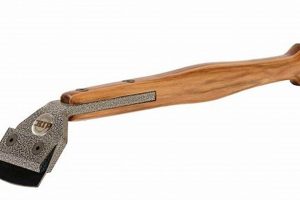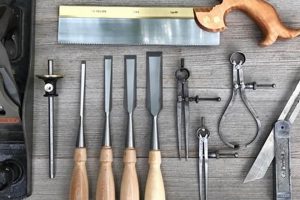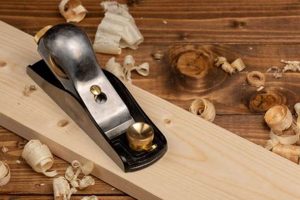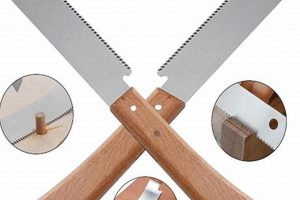The use of compact, manually-operated cutting tools in timber crafting constitutes a specific approach characterized by precision and control. A notable example involves creating intricate dovetail joints for drawer construction, where the tool’s maneuverability is paramount for achieving tight-fitting connections.
Employing these tools offers advantages such as enhanced tactile feedback, minimizing material waste, and fostering a deeper connection with the craft. Historically, these tools predate power machinery, representing a foundational skillset in woodworking traditions and promoting sustainable practices through reduced energy consumption.
Subsequent sections will delve into various types of these tools, proper techniques for their use, and strategies for their maintenance, aiming to equip the reader with the knowledge necessary to effectively integrate this approach into their woodworking projects.
Enhancing Precision and Efficiency
The following guidelines aim to optimize the application of compact, manually-operated cutting tools in timber crafting, emphasizing accuracy and efficiency.
Tip 1: Tool Selection: Choose the appropriate tool based on the wood type and cut complexity. Finer teeth are suitable for hardwoods, minimizing tear-out, while coarser teeth excel in softer woods for faster material removal.
Tip 2: Sharpening Regimen: Maintain a keen cutting edge through regular sharpening. A dull tool requires excessive force, compromising control and increasing the risk of error. Consult authoritative resources on saw sharpening techniques.
Tip 3: Kerf Management: Consider the width of the cut when planning joinery. Account for material loss due to the kerf to ensure accurate dimensions in the final assembly.
Tip 4: Workpiece Stabilization: Secure the workpiece firmly to prevent movement during cutting. Clamps, vises, or bench dogs provide stability, allowing for consistent and controlled strokes.
Tip 5: Stroke Technique: Employ a controlled, deliberate stroke, letting the tool do the work. Avoid excessive pressure, which can lead to binding and inaccurate cuts. Focus on maintaining a consistent angle.
Tip 6: Starting the Cut: Initiate the cut with precision using a starting notch or by carefully drawing the tool backward to create a groove. This prevents wandering and ensures accurate alignment.
Tip 7: Stance and Posture: Adopt a stable and balanced stance, maintaining a comfortable posture. Proper body mechanics contribute to control and reduce fatigue during extended cutting sessions.
Adherence to these guidelines will facilitate accurate cuts, improve efficiency, and enhance the overall quality of woodworking projects.
The subsequent section will address common challenges encountered when utilizing these compact tools and strategies for their resolution.
1. Tool Selection
The selection of the appropriate compact, manually-operated cutting tool is paramount in timber crafting. The choice directly influences the efficiency, precision, and overall quality of the finished product. A poorly chosen tool can lead to frustration, inaccurate cuts, and ultimately, project failure. Proper tool selection requires careful consideration of the wood species, the type of cut required, and the desired level of detail.
- Tooth Configuration and Set
Tooth configuration and set determine the tool’s ability to cut efficiently through different wood types. A finer tooth pitch is suitable for hardwoods, producing smoother cuts and minimizing tear-out. Conversely, a coarser pitch is more effective for softer woods, allowing for faster material removal. The set, or the amount the teeth are offset from the blade, influences the kerf width and the ease with which the tool moves through the wood. Improper selection can result in binding, excessive force, and a ragged cut.
- Blade Length and Flexibility
Blade length and flexibility dictate the tool’s maneuverability and suitability for specific cuts. Shorter blades offer greater control in tight spaces and for intricate cuts, while longer blades are better suited for straight cuts and larger workpieces. Flexibility, or lack thereof, affects the tool’s ability to navigate curves and contours. A rigid blade is ideal for precise, straight cuts, while a more flexible blade is necessary for curved or irregular shapes.
- Handle Design and Ergonomics
Handle design and ergonomics significantly impact user comfort and control. A well-designed handle should fit comfortably in the hand, allowing for a secure grip and minimizing fatigue. The handle’s material, shape, and angle all contribute to its overall ergonomics. A poorly designed handle can lead to hand strain, reduced control, and an increased risk of injury. The selection of a handle that suits the user’s hand size and grip style is critical for optimal performance.
- Saw Type Specialization
Specific tool types are designed for distinct cutting tasks. Dovetail saws excel in creating precise dovetail joints due to their fine teeth and stiff blade. Coping saws, with their thin, flexible blades, are ideal for curved cuts. Carcass saws offer a balance of features suitable for general joinery. Selecting the tool designed for the specific task enhances efficiency and accuracy.
Therefore, astute tool selection is not merely a preliminary step but an integral component of the entire woodworking process. The optimal selection, considering factors like tooth configuration, blade characteristics, handle design, and tool specialization, leads to higher quality outcomes and safer and more satisfying woodworking experience.
2. Sharpening Frequency
Maintaining an appropriate sharpening frequency is a critical aspect of efficient and precise timber crafting with compact, manually-operated cutting tools. The keenness of the cutting edge directly influences the tool’s performance, affecting cut quality, user effort, and overall project outcome. Inadequate sharpness leads to increased friction, reduced control, and compromised accuracy.
- Impact on Cut Quality
A dull cutting edge tears wood fibers rather than cleanly severing them. This results in a rough, uneven surface requiring additional sanding or planing to achieve a desired finish. For instance, attempting to cut a dovetail joint with a dull tool will yield ragged edges and a poor fit, compromising the joint’s structural integrity and aesthetic appeal.
- Influence on User Effort and Control
Using a dull tool necessitates increased force to execute a cut. This increased force diminishes control, leading to inaccurate cuts and a greater risk of slippage, potentially causing injury. Imagine attempting to rip a board with a dull saw; the increased effort will quickly lead to fatigue, compromising accuracy and safety.
- Correlation with Tool Longevity
Regular sharpening extends the lifespan of the tool. Allowing a cutting edge to become excessively dull necessitates more aggressive sharpening to restore its keenness, resulting in greater material removal. Frequent, gentle sharpening preserves the tools geometry and prolongs its usability. Neglecting sharpening leads to eventual replacement of the tool.
- Wood Species Dependency
Sharpening frequency is influenced by the type of wood being worked. Harder wood species, such as maple or oak, dull the cutting edge more rapidly than softer woods, such as pine or basswood. Therefore, a tool used primarily on hardwoods will require more frequent sharpening than one used primarily on softwoods. Adapt sharpening schedules based on the dominant wood type to ensure optimal performance.
The relationship between sharpening frequency and the efficacy of these compact tools underscores the importance of a proactive maintenance regimen. The frequency is not fixed; rather, it must be adapted depending on tool usage and the materials being processed. Regular maintenance ensures consistent performance, extending tool life and improving the quality of finished woodworking projects.
3. Kerf Allowance
Kerf allowance, the dimension of material removed by a saw blade during a cut, is a critical consideration in woodworking with compact, manually-operated cutting tools. Its omission from project planning introduces cumulative errors that significantly impact the accuracy of finished dimensions and the integrity of joinery. The width of the cut produced by these tools is typically narrower than that of power saws, but it remains a vital factor for precise results. For instance, when constructing a box with tight-fitting joints, failing to account for the kerf of each cut leads to an overall reduction in the box’s internal dimensions, potentially preventing intended contents from fitting properly. Furthermore, in joinery techniques such as creating tenons and mortises, neglecting kerf allowance compromises the snugness and strength of the resulting connection, rendering it structurally unsound.
The importance of kerf allowance is magnified in projects involving multiple components and intricate joinery. For example, building a complex cabinet with numerous drawers and shelves requires meticulous consideration of kerf for each piece. Errors accumulate with each cut; thus, accurate measurement and a consistent approach to kerf allowance are crucial. It’s standard practice to perform test cuts on scrap material to determine the exact kerf of a particular tool and blade combination. This value is then incorporated into the project’s cut list, either by adding material to the initial dimensions or subtracting the kerf value from the final dimensions of the pieces.
Ultimately, a thorough understanding and precise application of kerf allowance techniques represent a key difference between amateur and professional-level woodworking. Addressing this aspect of compact, manual timber cutting not only enhances the precision of individual projects, but also prevents unnecessary material waste. Mastering this seemingly minor detail constitutes a fundamental building block in developing advanced woodworking skills. The challenge lies in consistently applying this knowledge to every cut, regardless of the project’s complexity.
4. Workpiece Security
The securement of the material being worked is a foundational element when employing compact, manually-operated cutting tools in timber crafting. It directly impacts the accuracy, safety, and overall efficiency of the woodworking process. Insufficient stability introduces risks of inaccurate cuts, material damage, and potential physical harm to the craftsman.
- Clamping Mechanisms
Clamping mechanisms, such as bench vises, bar clamps, and holdfasts, provide a means of rigidly fixing the workpiece to a stable surface. A bench vise offers secure horizontal clamping, suitable for edge-cutting operations. Bar clamps allow for the secure joining of multiple pieces, preventing movement during glue-ups. Holdfasts, inserted into bench dog holes, provide vertical clamping pressure, useful for surface planing or sawing. Failure to use appropriate clamping introduces instability, leading to uncontrolled movement and potential errors in the cut. Inadequate clamping force can also result in the tool slipping, posing a safety hazard.
- Bench Dog Systems
Bench dog systems utilize strategically placed holes in a workbench to accommodate bench dogs or other clamping accessories. These dogs, typically made of metal or wood, provide a secure anchor point for the workpiece, preventing movement during cutting or shaping. A well-designed bench dog system offers versatility and adaptability, allowing for the secure clamping of workpieces of various sizes and shapes. Proper placement of the bench dogs, in conjunction with other clamping devices, ensures a stable and secure working surface. Utilizing this system correctly greatly enhances the safety and precision of hand tool operations.
- Non-Slip Surfaces
The use of non-slip surfaces, such as rubber mats or sandpaper adhered to work surfaces or clamping jaws, enhances friction and prevents slippage of the workpiece. These surfaces are particularly useful when working with smooth or irregularly shaped materials. The increased friction minimizes the likelihood of the workpiece shifting during cutting, ensuring accurate cuts and reducing the risk of tool slippage. Applying non-slip materials is a simple yet effective method of increasing workpiece security, particularly when combined with other clamping techniques.
- Proper Workholding Technique
Beyond the selection of appropriate clamping devices, the correct application of workholding techniques is critical. Ensuring that the clamping force is evenly distributed and that the workpiece is adequately supported is essential. Over-tightening clamps can damage the workpiece, while under-tightening provides insufficient security. Proper technique involves assessing the size, shape, and material properties of the workpiece and selecting the appropriate clamping method accordingly. Correct technique minimizes vibration and movement, resulting in cleaner, more accurate cuts.
The interplay between appropriate clamping devices, bench dog systems, non-slip surfaces, and correct workholding technique creates a stable and secure environment for using compact, manually-operated cutting tools. This optimized setup contributes directly to improved cut accuracy, enhanced safety, and a more efficient and enjoyable woodworking experience. A failure in any one of these areas can jeopardize the entire process, emphasizing the interconnected nature of these factors.
5. Stroke Control
Stroke control, in the context of manual timber cutting, refers to the deliberate manipulation of the tool’s movement to achieve a desired outcome. It encompasses the speed, pressure, angle, and length of each cutting stroke. Effective stroke control is not merely a physical skill, but a nuanced understanding of the interplay between the tool, the material, and the intended cut. Without precise stroke control, utilizing even the sharpest, most finely-tuned compact tool yields suboptimal results. For instance, attempting to create a clean shoulder line on a tenon without controlled strokes leads to uneven cuts and a joint that fails to seat properly. The act of sawing, therefore, becomes more than simply moving a tool back and forth; it transforms into a deliberate exercise in managing forces and manipulating the material to achieve the required geometry.
Proper stroke control directly translates to improved cut quality, reduced user fatigue, and increased tool longevity. A consistent stroke angle ensures that the blade remains aligned with the intended cut line, minimizing the risk of wandering or binding. Controlled pressure allows the tool to cut efficiently without excessive force, preventing premature dulling of the blade. A full-length stroke, when appropriate, maximizes the amount of material removed with each pass, reducing the overall cutting time. When executing dovetail joints, the ability to initiate and maintain precise strokes along the grain lines is paramount; deviations result in gaps and weakened connections. Furthermore, mastering this skill allows for the controlled removal of material in delicate situations, such as trimming a proud piece of inlay flush with the surrounding surface.
In summary, stroke control is an indispensable element. It is not simply a technique but a fundamental aspect of successful execution. While tool selection and maintenance are crucial, the user’s ability to govern the tool’s movement ultimately dictates the final result. Continuous practice, combined with a keen awareness of the material’s behavior, forms the basis for developing proficient stroke control, enabling the production of high-quality woodworking projects with precision and efficiency. The challenges of developing this level of mastery highlights its importance in the broader discipline.
6. Joint Precision
The degree of accuracy achieved in the fitting together of wood components directly correlates with the methods employed. Manual cutting implements necessitate refined techniques to realize high-tolerance connections.
- Kerf Management and Material Allowance
Consistent and precise kerf management is paramount. Failure to accurately account for the material removed by the saw blade results in dimensional discrepancies, directly affecting joint fit. A thorough understanding of blade thickness and its impact on material allowance is essential for achieving tight-fitting joints. For example, in constructing a mortise and tenon joint, an inaccurate kerf allowance leads to either a loose or overly tight tenon, compromising the joint’s structural integrity.
- Angulation Control in Mitered Joints
Maintaining precise angulation is critical when crafting mitered joints. Inconsistencies in the angle of the cut create visible gaps and weaken the overall structure. Attaining accurate angles necessitates meticulous measurement and controlled cutting strokes. Constructing a picture frame using mitered joints, for example, demands precise 45-degree angles to ensure seamless corners. Errors in angulation produce aesthetically displeasing gaps and compromise the frame’s stability.
- Surface Planarity and Joint Strength
The flatness of joining surfaces is a determinant of joint strength. Irregular surfaces create gaps and reduce the bonding area for adhesives. Ensuring surface planarity requires careful preparation of the wood stock prior to cutting joinery. Constructing a lap joint, where two pieces overlap, necessitates flat and even surfaces to maximize the glue surface and create a strong bond. Gaps due to uneven surfaces weaken the joint and reduce its load-bearing capacity.
- Tool Sharpness and Edge Definition
The sharpness of the cutting tool directly influences the definition of joint edges. A dull tool tears wood fibers, resulting in ragged edges and imprecise joints. Maintaining a keen cutting edge is essential for creating clean, sharp edges that facilitate tight-fitting connections. For example, creating a dovetail joint requires precise, clean cuts to ensure a secure and aesthetically pleasing fit. A dull saw produces ragged dovetails that do not interlock properly, compromising the joint’s strength and appearance.
These facets highlight the symbiotic relationship between technique and outcome. The utilization of compact, manually-operated cutting tools for achieving accurate joints demands a comprehensive understanding of material properties, tool maintenance, and refined execution. Consistent application of these principles ensures the creation of durable and aesthetically pleasing woodworking projects.
Frequently Asked Questions Regarding Small Hand Saw Woodworking
The following section addresses common inquiries and clarifies misconceptions concerning the practice of woodworking utilizing compact, manually-operated cutting tools.
Question 1: What constitutes a “small hand saw” in the context of woodworking?
The term generally refers to saws designed for detailed work and easy maneuverability, typically with blades ranging from 6 to 16 inches in length. Examples include dovetail saws, gent’s saws, and small back saws. Their compact size facilitates precise cuts in confined spaces and intricate joinery.
Question 2: Is proficiency with small hand saws essential for all woodworking projects?
While not universally required, skill in using these tools offers distinct advantages. They allow for greater control and accuracy in specific tasks, particularly those requiring fine details or intricate joinery. Furthermore, they provide a valuable alternative when power tools are impractical or unavailable.
Question 3: How does the use of small hand saws impact project timelines compared to power tools?
Generally, projects relying heavily on hand tools require more time than those employing power tools. However, the increased precision and reduced setup time for certain tasks may offset this difference. The choice depends on the project’s complexity, required accuracy, and the individual’s skill level.
Question 4: What are the primary maintenance requirements for small hand saws?
The most crucial maintenance tasks are regular sharpening and occasional cleaning. A sharp blade ensures efficient cutting and reduces the risk of errors. Cleaning removes resin and debris, preventing corrosion and maintaining smooth operation. Periodic handle adjustments may also be necessary to maintain optimal comfort and control.
Question 5: What types of wood are best suited for working with small hand saws?
While these tools can be used on various wood types, softer woods, such as pine and basswood, are generally easier to work. Hardwoods, such as maple and oak, require sharper blades and more controlled strokes. The selection depends on the project’s requirements and the user’s skill and experience.
Question 6: Are there specific safety precautions to consider when using small hand saws?
Workpiece security is paramount. The material must be firmly clamped or otherwise secured to prevent movement during cutting. Sharp tools should be handled with care, and fingers should be kept clear of the blade’s path. Eye protection is recommended to prevent injury from flying debris. Consistent adherence to safe practices minimizes the risk of accidents.
In summary, effective use of these implements necessitates a thorough understanding of the tools themselves, the materials being worked, and the associated safety considerations.
The subsequent section will delve into specific project examples demonstrating the practical application of these tools.
Conclusion
The preceding sections have presented a detailed exploration of “small hand saw woodworking,” emphasizing its importance in achieving precision, control, and a deeper connection with the craft. Elements such as tool selection, maintenance, stroke control, and workpiece security have been examined in terms of their impact on overall project quality and safety. The considerations detailed are intended to give a framework for successful implementation of these implements.
Mastery of “small hand saw woodworking” requires sustained effort and diligent practice. The ability to execute clean, accurate cuts manually represents a fundamental skill that enhances the quality and integrity of timber crafting endeavors. Individuals are encouraged to embrace the challenges and rewards associated with this technique, promoting both individual expertise and the preservation of valuable woodworking traditions.







